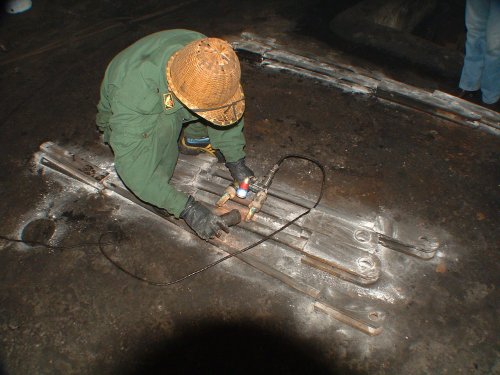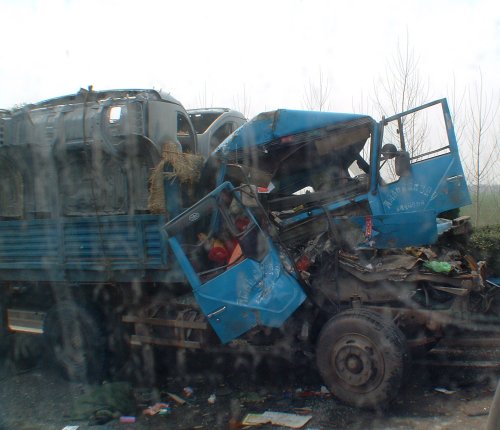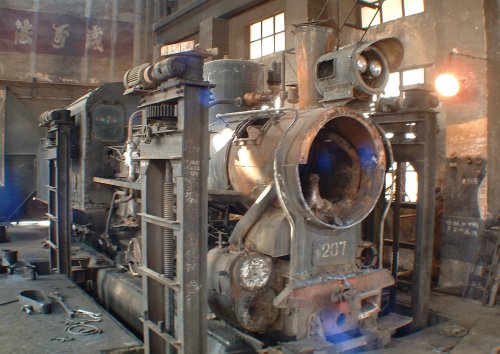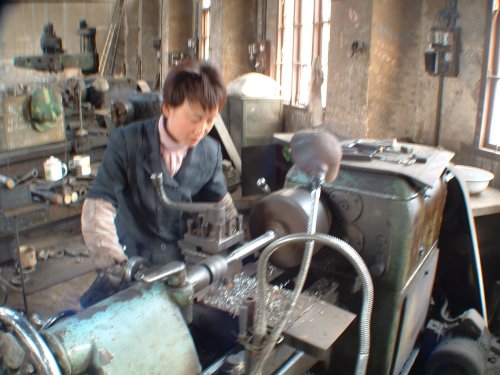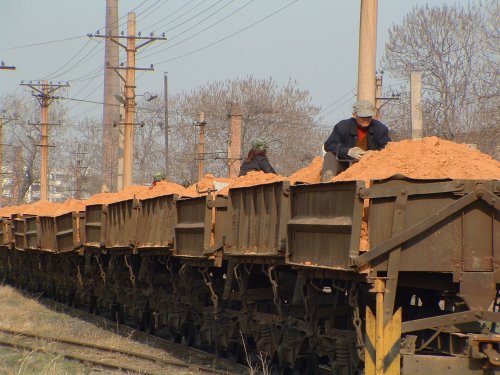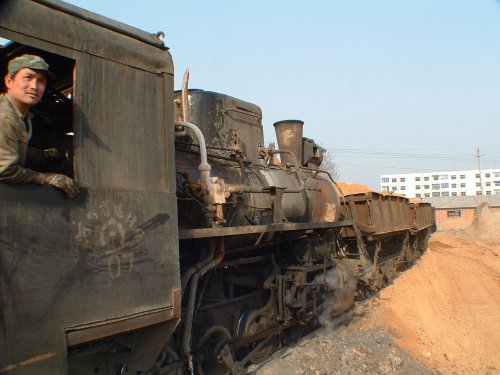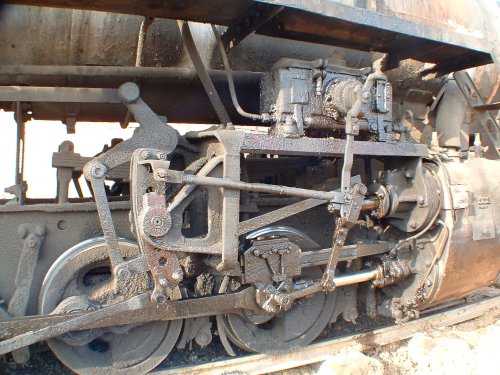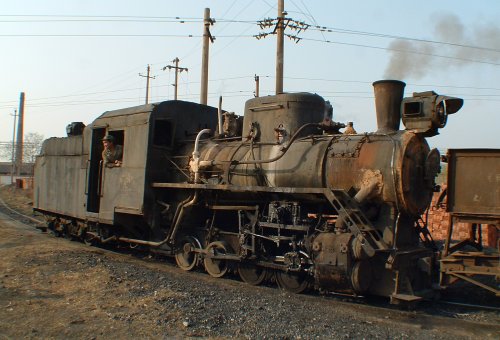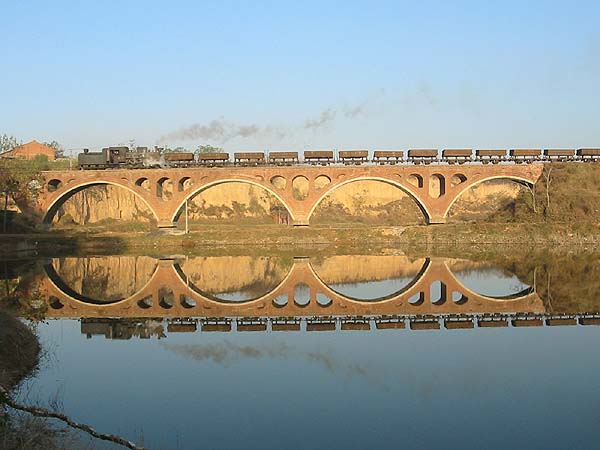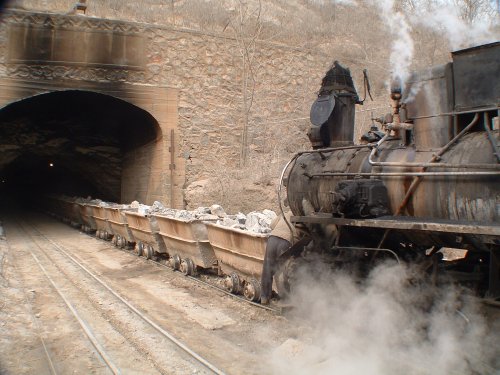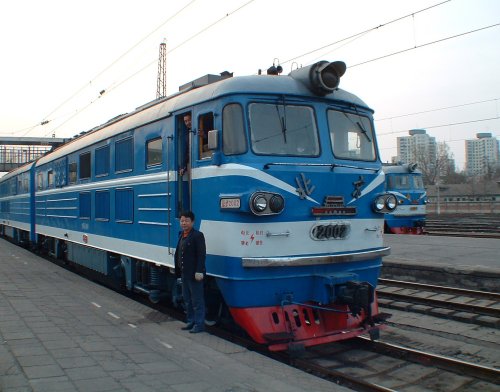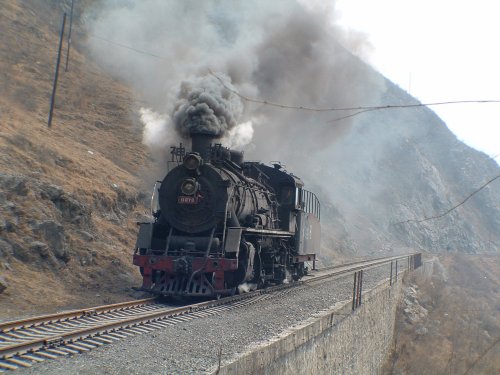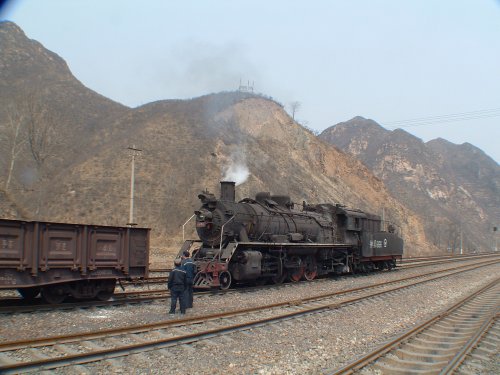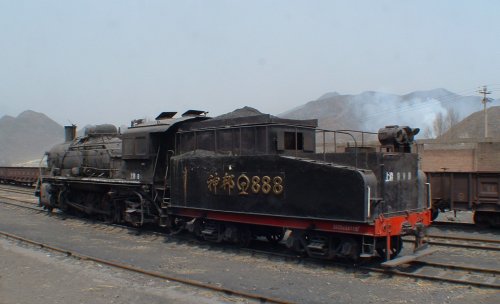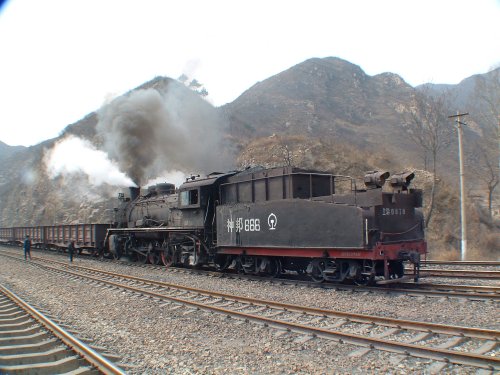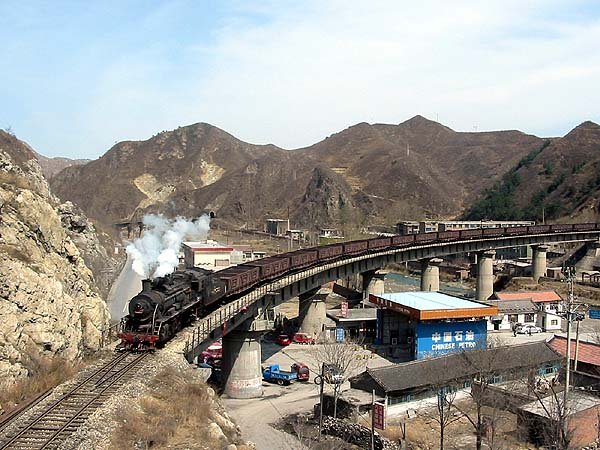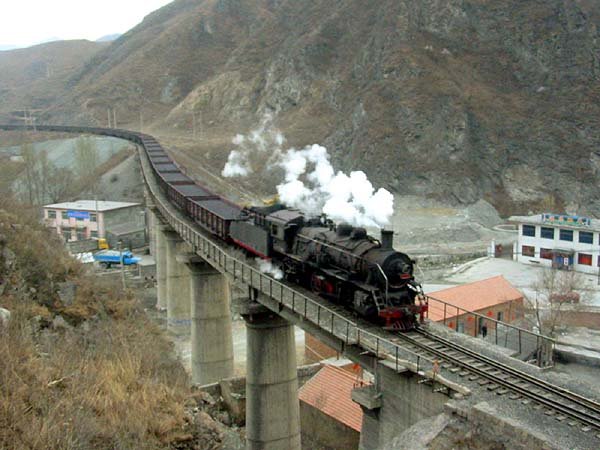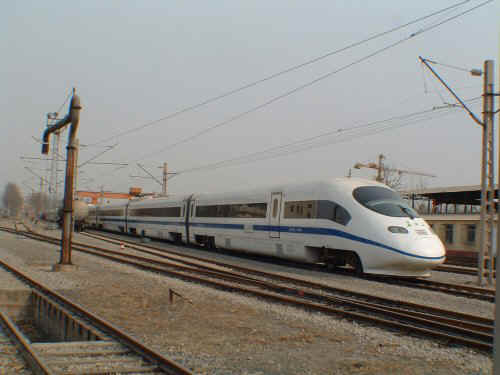|
Steam in China March 2005
I was fortunate, because of the need to be in China for business reasons to be able to take a quick look at four industrial railways still using steam traction in late March 2005.
Pingdingshan This railway has the most variety of loco's in use of any railway in China today. They use SY 2-8-2's, JS 2-8-2's of both versions and QJ 2-10-2's. They also have a fully equipped workshop capable of a complete overhaul of both chassis / running gear and boiler. Indeed on my visit to the works, a QJ class was stripped down to the bare frames with the boiler on a rotary cradle. Their back shop is well equipped with a wheel lathe and modern Chinese machine tools including a brand new radial arm drill. Interestingly despite the obvious investment in new equipment, they retain a milling machine from Newton of Pennsylvania built probably during WWII. Cab rides are freely given and generally speaking, no one will bother you if you are a single visitor.
Performing NDT on the brake rigging for a JS class loco.
Xingyang Brickworks Railway This small narrow gauge railway is located close to the city of Zhengzhou about 5 hours south of Beijing by train. It is known though for its erratic running schedule and many have made the trip only to find it closed up. Indeed my effort to see it running was almost thwarted too..... I had left Pingdingshan in the early morning with the intention of catching a train east from Zhengzhou after a quick look at this railway. Traveling north on the expressway on a bus, we were caught up in the most horrific chain reaction traffic accident one could imagine when up to 20 trucks and untold number of cars smashed into each other. Many were killed, even more injured. It took 4-5 hours to clean up the carnage.
This image was taken through the bus window.
I was just able to make a quick visit to the railway and found it working on a glorious spring afternoon. The railway has two of the standard Polish designed and Chinese built C2 class locomotives of the 0-8-0 wheel arrangement. One was in steam and the other was in their modest workshop receiving an overhaul. Again a cab ride was offered and accepted. I was cautioned before arrival not to enter the workshop without permission which, after hovering at the door for just a few minutes was freely given.
This is loco 207 on the jacks.
This machinist was single point screw threading a batch of shafts or were they boiler stay bolts? Loco 7 was up the line when we arrived. The switch person advised it would return in 30 minutes and sure enough after 30 minutes a whistle was heard.
Here the loaded wagons are rolling downhill past my vantage point with three brake operators on board after the loco had detached itself and run forward.
Shunting the loaded wagons at the unloading point
C2 0-8-0 motion on loco 7
Loco 7 getting ready to leave for another load of clay. I caught a cab ride as far as the watering point.
Image by Rob Dickinson, November 2004
Dahuichang Limestone Railway This railway is located just 20 km south of Beijing and can be reached off the Beijing Metro (underground ring railway) from Nanlishilu station with a bus ride on bus 937-3 to the end of the line. Again I was fortunate here as it was another glorious spring afternoon and, the railway was working normally. I found loco's 1 and 4 working with 2 and 3 in the shed under maintenance. What actually happened was this. I walked up the bank from the bus top to find loco 1 heading to the mine. The driver saw me, waved, I waved back and he then actually stopped the train, signaling me to climb aboard. This of course I readily did an off we went. The first thing I noticed when on the loco was that they are crewed by just one person. While perfectly acceptable for this operation, amazing all the same as it still seems typical in China to overstaff everything imaginable. I sat down on the fireman's side and off we went for the short journey to the mine (quarry?) Upon arrival, I cleaned the footplate of many pounds of spilled coal, banked the fire for the return trip and put on the injector while the driver had a cigarette. We then dropped our empty train and pushed the previous load of empties into the underground loading area where a cable system picks them up and takes them on. A few minutes later the loaded wagons were back at the mine entrance.
Hooking on to the loaded wagons which have been released from the cable system for the trip back to the crushing plant. Upon arrival at the rock crushing plant I discovered another interesting operational difference with this railway. While the loco is operated by one person. That person changes for each trip. So we got off the loco and another driver got on. I sat on the bench with the other crew and gave out some train related badges I was carrying for the purpose, taking in the atmosphere, nudging myself to remember this was 2005.... The next train was ready to leave and the new driver again motioned me to the cab. This this time though he offered me the drivers seat which I readily took. He allowed me to perform the entire cycle of running, shunting, propelling and the return journey with the loaded wagons. Click here to see a short video clip of double track, working narrow gauge steam in 2005... There has been some trouble here in the recent past with groups of visitors and crews demanding (and receiving) money to operate loco's for photo's etc. With some observation it is possible to separate the crews into two groups. Several wear a beige jacket and are, as described above "salt of the earth", very happy to share their world and receive a pin as a goodwill gesture. A couple of them though wear black leather jackets (supervisors?) one who drove a turn just looked the other way when he saw me and another made the universal gesture of rubbing fingers and thumbs together, coupled with some hand waving. Clearly indicating to me he wanted money for something. I did not even give him a pin. Loco 1 came by with the first driver I had met in charge, he slowed, I jumped up and we were gone leaving the leather jacketed "gripper" standing there...... At about 4:45 pm after three round trips (for me), the railway stops working for meal time. This is signified to the casual observer by a light engine working back to the rock crushing plant. So at this point, I bade my new acquaintances farewell and headed back into town. After the line closed in June 2005. Locomotive "# 4" was moved to North Wales .
Shenbang Mineral Company This railway is newly discovered for westerners by the young Taiwanese Hsiang Tseng. As I had a spare day before flying home, I decided to go and take a look. It is located 175 KM SW of Beijing on the line to Taiyun at the small town of Fu Tu Yu. The train, 7095 from Beijing, left the Nan (south) station at 6:37 am and takes 5+ hours for the journey. The cost of a seat is only 12Y (1.50 USD) each way. Note: Fu Tu Yu issues the old style cardboard tickets for outbound journeys. The scenery improves progressively as the journey unfolds with many high bridges and tunnels. A good portion of the line is single track. At one point about 2 hours from Beijing we passed over a narrow gauge railway with significant activity. There are many mines and quarry's on this journey and one also passes a huge oil refinery. These 1980's built loco's hauled the train. I've no idea what type they are . They only work the passenger trains and only in pairs. I saw a total of four pair this day including 2001.
Top writing reads "Beijing Bureau, Beijing Section" the home base for the loco. The builders plate reads "Railroad Ministry, Beijing 2/7 (February 7th) Locomotive factory 1986"
Upon arrival in Fu Tu Yu where there are four side tracks beyond the platform, I could see no evidence of steam activity, not even a water column or ash between the tracks. There was though a branch line leading over a curved viaduct to a tunnel so I decided to start walking. Walking over the viaduct I turned to see a huge drag of empty wagons emerge from a tunnel on the main line, hauled by a diesel. I watched for a minute as it disappeared into an avalanche shelter and then out of sight as it approached the station area. Continuing to walk over the curved viaduct I approached the tunnel which is fairly short. Walking through the tunnel I heard a steam loco whistle. I ran beyond the tunnel and stepped up on to a low bank to see an SY coming off another viaduct heading towards me at a fair clip, light engine. Clearly she was heading down to the C.N.R. station to pick up the empties I'd just seen arriving. I grabbed a quick photo and waved to the crew.
SY "666" charging downhill to meet the C.N.R. train just before the tunnel. The second viaduct is over to the right. As the loco passed the crew spotted me and the brakes were slammed on, the loco slid past and into the tunnel. I ran after them as the driver prepared to back up. By this time all five of the crew (driver, fireman and three shunters) were hanging out of the windows pointing and waving, clearly thrilled to see a "foreigner". I was invited up into the cab with hand shakes all round. We then continued the journey down to the C.N.R. station. Upon arrival, we crossed into the center road to pick up the wagons.
SY "666" at Fu Tu Yu picking up empties We hooked on to the load of empties while the fireman banked the fire for the run back up what I now knew to be a significant climb to the loading point. After pumping up the brakes we set off. Beyond the tunnel the grade increases and the loco struggled with the load, much sand being applied to the track. The driver though left the throttle at about 75% for the whole climb while carefully and very skillfully adjusting the cutoff to deal with the conditions. I thought we had taken half the empties but was to find out we had just a third of them. We dropped the wagons in the yard where I could see the second SY "888" sitting cold on an adjacent track. It was quite evident that the crew were not used to hosting visitors as they took great pain to warn me about burning myself on the back-head to the point of finally, the fireman disappeared and came back with a brand new pairs of work gloves for me to wear.
SY "888" with large tender number and logo. The numbers and logo though are not brass but thin sheet steel with brass plating on them. The writing reads "Powerful State" After dropping the empties for a crew to wire the doors shut, we headed back down to the C.N.R. station. Upon arrival, we hooked on and the fire was banked again. This time though we left with a tremendous effort at maximum acceleration by the driver and hit the first curved viaduct at a good speed. In doing this we had no trouble making the grade, the loco taking the load easily. .
Banking the fire and pumping up the train brakes ready for the second run. Dropping the second set of empties we then moved the first set over to the loading line where a front end loader filled them from the side with processed low grade iron ore pellets (called Taconite). We then set off back to pick up the third load of empties which was brought up with a similar good effort. With all three portions of the train now at the loading point, the loco hooked on to the first set we had brought up and started pushing the wagons over the weigh bridge one at a time for "topping off". The weigh bridge is operated by a C.N.R. person in uniform and clearly this is how they know when to dispatch a steam loco the C.N.R station. I handed out pins to everyone, said my goodbyes and made my way on foot back to the C.N.R station to catch the 16:41 train, number 7096 back to Beijing. Upgrade to hard sleeper was available for 44Y on board. A little anecdote, I was walking back through the village to the C.N.R. station and in need of something to eat before the 5 hour journey home on a train that does not have a restaurant car. I spotted a small place but at the end of my two week trip I was pretty "riced and noodled out". I sat down at one of the three tables and ordered a coke which I could see another guy drinking. Looking around I decided there was nothing to do but go look in the kitchen. To my delight I spotted a bowl of freshly peeled potatoes and a box of eggs. I pointed at the potatoes and received a puzzled look so I took the meat cleaver and started to chop them for chips (fries) After a lengthy "conversation", much pointing and arm waving the cook got the message and presto one plate of egg and chips and boy did that hit the spot.... I did not see the full train delivered to the C.N.R. I'm now told the full trains go down on one piece and are of course huge in length! All trains leave eastbound for Shijiazhuang Steelworks. These two images were received from another source on April 9th 2005 showing "888" on a loaded train. Loaded trains are confirmed as at best one per day but there are days when there are none.
The lower viaduct near the C.N.R station, you can see the C.N.R. viaduct beyond the steam.
This is the upper viaduct approaching the tunnel I could not see where the loco's were maintained but have now been told the maintenance is done on site except for heavy overhauls. Recently (October 2006) a third SY numbered "999" has been seen here. There were more branch lines at other stations on the journey, one in particular a couple of hours back in the Beijing direction that needs investigation as I saw a headlight poking out of a shed.
Beijing Railway Museum I found this experience to be a bit disappointing, I was the only one there and left after a just a short time thinking maybe it will be better in another five years or so. I did though see this train on the test track.
Note the water column and inspection pit in the foreground, quite the contrast and, just maybe we will see museum loco's using the test track on weekends in the future?
Beijing Aircraft Museum Just a quick note about this excellent museum located 40 KM north of the city. First time I've ever been to a museum that has preserved an entire squadron of one type of Aircraft, the MiG 15. All lined up in a row like the day they were retired. Interestingly for me, there were two Russian "knock offs" of the Boeing B-29 strategic bomber but with turbine engines fitted. One also had a radar dome similar in external appearance to an AWACS plane. There were also several C-47's I assume acquired in the same manner. This web site discusses in more detail The China Aviation Museum The primary portion of the exhibits is stored in the former operational hangers under a mountain and include a P51 Mustang and a Mosquito which both flew in the first review of the PLA Air force in 1949. The museum can be accessed from Lishuiqian station on the new line 13 of the Beijing Metro which at this point is elevated and by 912 bus from there. From this station though it is still a long ride to the museum. On my journey the bus terminated a few KM before the museum for reasons I'm not sure. We were just "turfed off" on to the side of the road. I completed the journey by Taxi. Upon departing the museum I found bus 912 waiting to take me back to the Metro albeit after finishing its outwards journey. Chinese text translations by Lily Zhong. Trevor Heath Port Orchard, Washington USA
|
